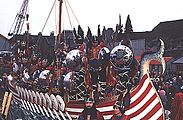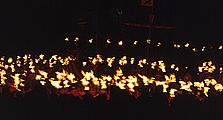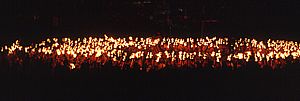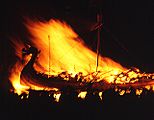Up Helly Aa facts for kids
Quick facts for kids Up Helly Aa |
|
|---|---|
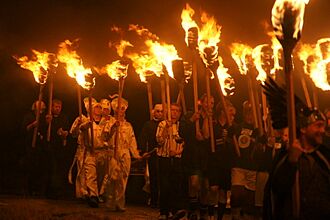
|
|
| Observed by | Residents of the Shetland Islands |
| Significance | Traditional end of Yuletide in Scotland |
| Celebrations | Torchlight procession, burning of a replica Viking galley, guizing, parties, charades, ceilidhs |
| Begins | Last Tuesday of January |
| Ends | March |
| 2024 date | 30 January |
| 2025 date | 28 January |
| 2026 date | 27 January |
| 2027 date | 26 January |
| Frequency | Annual |
| First time | 1881 |
Up Helly Aa is a famous fire festival that takes place every year in Shetland, Scotland. Held between January and March, it marks the end of the Christmas season, known as Yule.
The festival is famous for its amazing torchlit parades. People dress up in costumes and are called "guizers." The highlight of the event is when they burn a life-sized model of a Viking galley (a type of ship). The biggest festival is in Lerwick, Shetland's main town. There, up to a thousand guizers march through the streets on the last Tuesday of January. Smaller festivals also happen in other villages across Shetland.
Contents
History of the Festival
The Up Helly Aa festival we see today started in the 1800s. It grew out of an older tradition where young men would drag barrels of burning tar through the town on sleds. This was often messy and caused trouble.
After the Napoleonic Wars, young men returning to Shetland wanted to create a more organized and exciting event. They were inspired by the islands' Viking history. Around 1880, the tar barrel tradition was stopped. Instead, they were allowed to have torchlight parades.
The First Viking-Themed Festivals
The first torch parade on Up Helly Aa day was in 1881. The festival became even bigger in 1882 when Duke Alfred, a member of the royal family, visited. The first Viking-style galley ship was built and burned in 1889.
A Shetland author named Haldane Burgess helped shape the festival's Viking theme. He wrote a book called The Viking Path and also wrote the "Up Helly Aa Song." This song is still sung today when the galley is burned.
What Happens at Up Helly Aa Today?
The modern festival is a huge community event. It is celebrated in eleven different places across Shetland.
The Jarl and the Guizers
Each festival is led by a main guizer called the "Jarl" (pronounced "yarl"). The Jarl represents a famous figure from Norse legends. To become the Jarl in Lerwick, a person must be on a special committee for 15 years.
The Jarl leads a group called the Jarl Squad. They wear amazing, detailed Viking costumes. Other groups of guizers, called squads, also dress up in creative costumes. After the parade, the squads visit local halls for parties. They perform funny skits, sing songs, or dance for the community.
A Festival for Everyone
The festival has changed over time to include more people. In the past, only men could be guizers in the main Lerwick parade. However, women and girls now take part in many of the smaller festivals. In 2015, the South Mainland festival had its first female Jarl. Since 2023, women are also welcome to join squads in the Lerwick festival.
What Does "Up Helly Aa" Mean?
The name of the festival comes from old words. According to dictionaries of the Scottish language:
- Up comes from the Old Norse word uppi, which means something is finished or over.
- Helly comes from the Old Norse word helgi, which means a holy day or festival.
- Aa means "all."
So, "Up Helly Aa" can be understood as "the end of all the holidays."
Lerwick Up Helly Aa Gallery
See also
 In Spanish: Up Helly Aa para niños
In Spanish: Up Helly Aa para niños
- Burning the clavie
- Olavsfestival
- Ólavsøka




